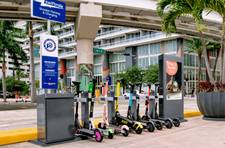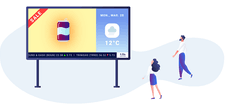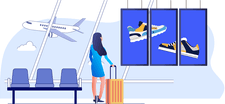As digital out-of-home continues to gain traction, media buyers are looking for even more exciting ways to reach their audience through context-based dynamic advertisements. And while one screen is great, using multiple screens to present campaign content can create a truly immersive experience.
This could mean displaying one piece of creative across multiple displays, using multiple displays as a larger, cohesive canvas, or having multiple screens display related content in sync with one another.
For any of these scenarios, you’ll need hardware that’s capable of driving content to multiple screens at the same time. But you’ll also need to make sure that your digital signage software supports multi-screen and synchronized playback. Fortunately, the Broadsign platform makes deploying these kinds of campaigns very straightforward, and actually offers a number of options for getting the job done.
Here’s a quick look through the different kinds of multiscreen content that Broadsign enables, as well as the hardware requirements and the specific features for bringing them to life.
What does “multi-screen playback” mean in OOH?
Before we dive into some of the different scenarios that are possible with Broadsign’s digital signage software, let’s make sure we’re all on the same page. When we talk about displaying content on multiple screens, there’s a few different things that could mean:
- Targeting multiple pieces of content to multiple screens
- Duplicating a single piece of content across multiple screens
- Synchronizing playback of a single campaign across screens
Just playing content such as video, sound, graphics, animation, and more on a display isn’t that big of a challenge for your average digital signage software. Incorporating multiple displays for content delivery, though, is something a bit more specialized. For most multiscreen deployments, you’ll need an ad server powering content delivery behind the scenes.
Just using an ad server, though, won’t necessarily mean the content will play across the target displays in sync with each other. And if you want to show a common message across many screens, the impact will be greater if the display content is synched, especially if the display layout means there are multiple screens within the audience’s field of vision. If the content is even slightly off on each screen, you won’t achieve an effect that audiences will enjoy or that buyers will appreciate.
So how do you make sure content plays back in perfect unison across multiple devices? For that, you need digital signage software that supports synchronization: a feature that lets computers communicate with one another in real-time.
Why synchronize digital signage players?
Individual media players in a digital signage network typically operate independently of one another; each player receives media files and scheduling information from a back-end server, then pushes the content out to your connected digital signage display.
While every media player in your network communicates with the server at regular intervals, these content updates don’t necessarily happen at the exact same intervals. To further complicate things, leading digital signage and digital out-of-home solutions like Broadsign don’t typically operate in a way where a specific campaign will be scheduled to play on a specific display at a specific time. Instead, ads are assigned playback rules and the scheduling software has the flexibility to play the same ad at different times on different screens, provided those times and screens match the ad’s criteria. This means that you can’t rely on basic scheduling to synchronize playback; you need additional functionality to get the job done.
But, why? When you install many screens in the same area, you need to think about how content across those screens might be viewed by a viewer at any given moment. If the content is meant to be replicated or coordinated across all screens and the timing for changing the onscreen campaign is slightly off, it will detract from the potential impact of a multi-screen installation. Synchronization is crucial for running dynamic campaigns spanning multiple screens and display units (in fact, without it such campaigns wouldn’t even be possible), but it also helps ensure the end result meets your expectations.
To put it simply: If your audience can see more than one of your screens at the same time and you’re trying to coordinate content across those screens, you’ll need to invest in a solution that has dedicated playback sync functionality.
Synchronizing multi-screen playback with Broadsign
With Broadsign’s industry-leading digital out-of-home software, you can configure the content of one screen (or one section of a screen) to trigger playback of content in another screen (or another section of a screen) by using a leader/follower configuration. That way, you can ensure that the same content is playing on multiple screens or sections of screens.
Broadsign offers you the possibility to perform several types of synchronization. Choosing the right features or strategy will depend on a number of factors, including the campaign capabilities you want to enable, the hardware configuration of your multi-screen setup, and whether the players you want to sync are on the same Wifi/LAN network.
Frame synchronization
When you need to:
- Sync two sections of the same screen
- Sync two screens connected to the same player
If you need to sync two parts of the same screen, or, if you need to sync two screens that are connected to the same player, then frame synchronization in Broadsign Control has got you covered.
Frame synchronization lets you configure the content of one frame to trigger playback of content in another frame, a feature that’s also known as “triggering”. The triggering content (i.e., the content displayed on the “Leader” frame) can be the same as the content that appears on the “Follower” frame(s), or it can be frame-specific. This synchronization technique can be applied anytime you want to divide a larger screen into separate sections.
For example, imagine that you have a digital bus shelter with two frames on a single screen: a main frame, and a sidebar. When an ad for McDonalds’ daily drink deal appears on the main frame, you want directions to several of the nearest locations, along with estimated walking times, to appear on the sidebar. With frame synchronization, you can configure your display so that when the McDonalds ad appears, it triggers playback of the nearest location information at the same time.
While a frame is generally a section of a single screen, there are certain scenarios where you can use frame synchronization to drive frames that live on different screens (where one frame is on one screen, and the other frame is on the other screen). This setup is common to standalone totems that have screens on two sides, such as those used by EV charging networks and smart city installations. The main requirement here is that all of the frames you want to synchronize need to be connected to the same digital signage player.
Frame synchronization is relatively inexpensive (since it only requires one digital signage player), and is an easy way to display basic 1080p video content across multiple sections of a single display. But it’s not well-suited to every situation where multi-screen playback is required. While one media player can typically run one large display or many small frames in sync, many players may need to be used when running many large displays. In fact, you’ll generally want to have a quality digital signage player for every digital display in your network.
Multi-frame layouts that use dynamic content, such as HTML5 animations, will also put more of a strain on most player hardware on the market today. If you want to run dynamic, 4K content on both frames, you’ll need a more powerful player that’s specifically equipped to handle a higher resolution.
Multi-player synchronization
When you need to sync two screens connected to different players:
- If they’re on the same wifi/LAN network: Network synchronization
- If they’re on different wifi/LAN networks: 3G synchronization
Multi-screen installations can be used to create amazing digital signage video walls and dramatic location takeovers that are perfect for when an advertiser wants to make a big impact. With network synchronization and 3G synchronization in Broadsign Control, you can seamlessly sync campaigns across multiple digital signage players and screens.
“Regular”, or same network player synchronization, enables synchronized playback between Broadsign players that are on the same LAN network, and 3G sync does the same for Broadsign players on different LANs. Both strategies build on Broadsign’s existing trigger feature, which uses a leader/follower configuration similar to the mechanism used in frame synchronization: one screen/player is designated as the “Leader” and sends triggers to the “Follower” player(s). Synchronized content can be identical or screen-specific, but ideally, the followers have the same loop length, slot length, hardware, and clock settings as the leader.
Multi-player synchronization is necessary any time you want to sync content across multiple displays within your field of vision that are being run by more than one player. This situation is often seen in place-based setups in restaurants, train stations, and retail stores, but the same technique is also used for larger format video walls and immersive outdoor displays. Imagine an advertiser wants to mount a full-scale location takeover that involves multiple digital billboards all displaying content in sync. In a situation like that, you’d definitely want to be able to enable multi-player sync.
Network synchronization and 3G synchronization are basically alternate methods for achieving the same goal; the main difference to note here is that playback on same-network setups occurs when the trigger is received, whereas on 3G sync networks, the trigger arrives with a timestamp and playback occurs at that time.
Synchronization with third-party player software
When you need to sync two or more screens connected to different players & at least one player uses non-Broadsign software to play content
What if you want to enable multi-screen campaigns, but your network includes a mix of Broadsign players and players running third-party software? For situations where you might need a bit more hardware flexibility but don’t want to sacrifice on software features, Broadsign Air, our intelligent cloud-based ad server, can help you make it happen.
Broadsign Air lets you add non-Broadsign players to your network and brings the same ad-serving capabilities of Broadsign Control to third-party players. Air-connected players can be centrally managed through the Broadsign Control administrator tool and will be able to benefit from most of the same great features as full-fledged Broadsign players. One limitation to note, however, is that Broadsign Air does not support multi-frame playback or synchronization.
It’s also important to note that Broadsign Air isn’t standalone software capable of playing content on its own; it needs to be connected to separate player software that can play the content it serves. You’ll also need a Broadsign Control license in order to access its scheduling and ad-serving capabilities on your third-party player. But once you’re set up, you’ll still be able to sync content and campaigns between all of your networked players with ease.
Learn more about our intelligent cloud-based ad server: Broadsign Air
Duplicating a single input across multiple screens
When you need to:
- Display duplicate content on two screens
- Run a basic, single-screen campaign on multiple screens
There’s another, more basic, option we haven’t discussed yet, and that’s because it technically doesn’t involve synchronization. While all of the strategies outlined above can be used to display either duplicate or screen-specific content across multiple screens, there are some situations where you might not need both capabilities. If you simply want to display duplicate content across more than one screen, it’s sometimes possible to do so with the help of a video splitter: a device with several output signals that connects to a digital signage player and transmits the same content to multiple screens.
You might see a video splitter setup used in a hotel lobby or the atrium of a movie theater—places where multiple screens are installed in the same area, and each screen is displaying the exact same thing. Another common use case for a video splitter is when retail stores like Best Buy or Costco display duplicate video content across multiple TVs in order to show buyers the difference in quality. Video splitters might make sense for straightforward setups like these, where a single, basic piece of content is simply being duplicated across multiple screens; since only one player is required to provide output, video splitters can help smaller networks save on licensing costs.
Outside of very specific scenarios, however, video splitters aren’t generally a suitable option for digital signage networks. For one thing, they’re quite limiting in terms of the content you can duplicate and display, since they can only handle static images, text, and basic 1080p video. Even then, the video signal degrades slightly each time it’s split, resulting in loss of video quality. Network owners looking to capitalize on the rising demand for dynamic DOOH amongst ad buyers should instead invest in the technology required to meet this demand.
Want to make multi-screen content playback easier?
Get your Broadsign demo to see how it’s done











